Click on images to enlarge

dense infestation on the edge of a revegetation area (Photo: Sheldon Navie)

infestation of young plants (Photo: Sheldon Navie)

habit (Photo: Sheldon Navie)

older stems (Photo: Sheldon Navie)
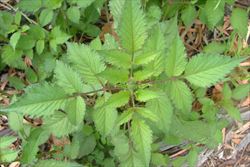
oppositely arranged lower leaves (Photo: Sheldon Navie)
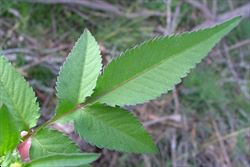
close-up of leaf with sharply-toothed margins (Photo: Sheldon Navie)
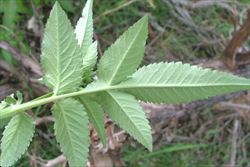
leaf undersides (Photo: Sheldon Navie)

close-up of immature fruit (Photo: Sheldon Navie)

mature fruit (Photo: Sheldon Navie)

close-up of seeds (Photo: Steve Hurst at USDA PLANTS Database)
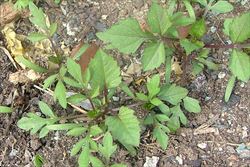
seedlings (Photo: Sheldon Navie)

dense infestation along the Brisbane River (Photo: Sheldon Navie)

infestation in a forest understorey in Redland Shire (Photo: Sheldon Navie)

habit (Photo: Sheldon Navie)

narrower upper leaves and flower-head without any 'petals' (Photo: Sheldon Navie)
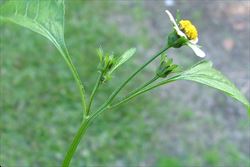
alternately arranged uppermost leaves with young flower-heads (Photo: Sheldon Navie)
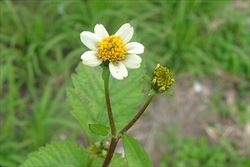
flower-head with several white 'petals' (Photo: Sheldon Navie)

close-up of flower-head from below, showing the two rows of floral bracts (Photo: Sheldon Navie)
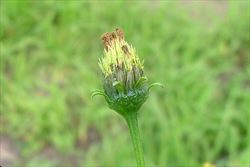
close-up of young fruit (Photo: Sheldon Navie)
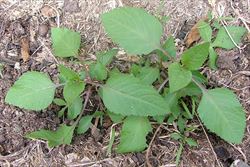
young plants with simple leaves (Photo: Sheldon Navie)
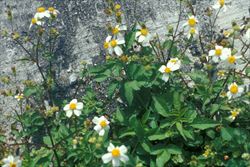
beggar's-ticks (Bidens alba var. radiata), which has flower-heads with larger white 'petals', is mainly found in central and northern Queensland (Photo: Forest and Kim Starr, USGS)

greater beggar's-ticks (Bidens subalternans) has more deeply-divided leaves and flower-heads with yellow 'petals' (Photo: Sheldon Navie)

bipinnate beggar's-ticks (Bidens bipinnata) has more deeply-divided leaves and flower-heads with yellow 'petals' (Photo: Chris Gardiner)
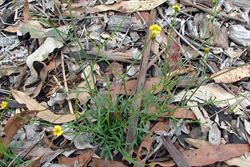
native cobbler's pegs, Glossogyne tenuifolia (Photo: Sheldon Navie)
Scientific Name
Bidens pilosa L.
Synonyms
Bidens chinensis Willd.Bidens leucantha Willd.Bidens pilosa L. var. minor (Blume) Sherff
Family
Asteraceae (Queensland, New South Wales, the ACT, Victoria, Tasmania, Western Australia and the Northern Territory)Compositae (South Australia)
Common Names
beggar's tick, beggar's ticks, black jack, bur, bur marigold, butterfly needles, cobbler's peg, cobbler's pegs, cobbler's-pegs, common beggar-ticks, common blackjack, farmer's friend, hairy beggarticks, hairy beggar-ticks, needleandthread, pitch forks, pitchforks, shepherd's needles, Spanish needle, Spanish needles, stick tights, stickybeak, white beggarticks
Origin
This species is now very widespread throughout the warmer regions of the world, but is thought to have originated in tropical America (i.e. in Mexico, Belize, Costa Rica, El Salvador, Guatemala, Honduras, Nicaragua, Panama, the Caribbean, French Guiana, Guyana, Surinam, Venezuela, Brazil, Bolivia, Colombia, Ecuador, Peru, Argentina, Chile and Uruguay).
Naturalised Distribution
A widely naturalised species that is particularly common in the eastern and northern parts of Australia. It is widely naturalised throughout Queensland, eastern New South Wales, the Northern Territory and the northern parts of Western Australia. Less common in the ACT, in some parts of Victoria and South Australia, and in south-western Australia. Also naturalised on Lord Howe Island, Norfolk Island and Christmas Island, and in many other parts of the world.
Notes
This common weed grows in a wide variety of habitats. Cobbler's pegs (Bidens pilosa) is well known as a weed of gardens, parks, crops, pastures, roadsides, disturbed sites and waste areas, but it also invades waterways, rainforest margins, open woodlands and coastal sites (particularly in warmer regions). For this reason it is also regarded as an environmental weed in New South Wales, Queensland, Western Australia and the ACT.
Cobbler's pegs (Bidens pilosa) was recently listed as a priority environmental weed in two Natural Resource Management regions and in south-eastern Queensland it is considered to be among the top 200 most invasive plant species. This species is readily dispersed by man's activities and dense populations can out-compete native species on the exposed margins of bushland and in revegetation sites.

